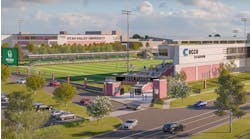On Sept. 2, 2000, the Southern Methodist University Mustangs played a football game on its Dallas campus for the first time in nine years.
That date marked the premiere of the Gerald J. Ford Stadium, a 32,000-seat facility that was built on the site of the former Ownby Stadium. Attached to the northwest corner of the new facility is the Paul B. Loyd Jr. All-Sports Center. Together, the facilities cost $57 million.
The new stadium has allowed SMU to return home football games to its campus. The team has been playing home games at the Cotton Bowl.
Designed by Ellerbe Becket, the Ford Stadium and All-Sports Center are intended to reflect the heritage of Ownby Stadium and the design vocabulary of Southern Methodist University, yet also convey a sense of excitement for game days and the athletics program.
The familiar details of an SMU building are found in the new facilities - from the eclectic brick blend to the warm, colored stone and arched walkways - even a domed cap to the entry of the All Sports Center.
Ford Stadium has 240 preferred club-level seats and 240 more seats in 23 luxury suites that have televisions, air conditioning and refrigerators. A three-level press box can accommodate 125 media representatives.
More than 100 television monitors are placed throughout the stadium, and an oversized videoboard will show highlights, replays and action.
The layout of Ford Stadium is a "horseshoe"-shaped bowl, with the open end facing Mockingbird Lane. This arrangement helps maintain the green space so prevalent along Mockingbird.
The playing field is recessed 24 feet below ground, the purpose of which is twofold: first, it creates an intimate bowl, with 24 rows above ground and 24 below. Even the last rows have great views and feel like a part of the action. Second, it allows the stadium to be a "good neighbor," both to the rest of the campus and surrounding areas - by recessing the playing field, the exterior wall is only 35 to 40 feet instead of 60 to 75 feet tall. The open end of the bowl also allows for sloped grass seating and an area for corporate tents, creating a festival atmosphere.
A student section of the stadium is set aside for 4,500 students. The stadium was designed to accommodate expansion to a capacity of 45,000. The field is large enough to hold a regulation soccer field.
The All-Sports Center is a 124,000-square-foot facility that houses the offices of the football, track and field, and soccer teams. The center also will feature Heritage Hall, which will be filled with artifacts, trophies and treasures honoring SMU legends from all sports. The hall's official opening will take place in 2001.
On the lower level is a weightroom where all student athletes train. It also houses the Altshuler Learning Enhancement Center, which is staffed with tutors and study aides, and is offered free to all Southern Methodist students.
Ford Stadium will be fully accessible to all patrons. The simple configuration of the seating bowl will allow patrons in wheelchairs to enter directly through the same portals as other patrons, and immediately wheel into locations at the top of the lower rows. These locations are provided around the circumference of the bowl. In addition, the seating section is designed so that a fan in a wheelchair can see over a fan who stands in front of them.
All restrooms and concession stands are designed to meet accessible standards. The All-Sports Center and press box are served with elevators to allow access to all levels of seating, offices, training facilities and the Altshuler Learning Enhancement Center. Accessible parking spaces are the closest to the building on the north side, and accessible entrances are marked clearly .
The stadium was named for Ford - not the former U.S. president, but a bank executive who received bachelor's and law degrees from SMU in the 1960s. He donated $20 million for the stadium construction. Loyd, an executive with an off-shore drilling company, is an SMU alumnus and was captain of the 1967 football team.

